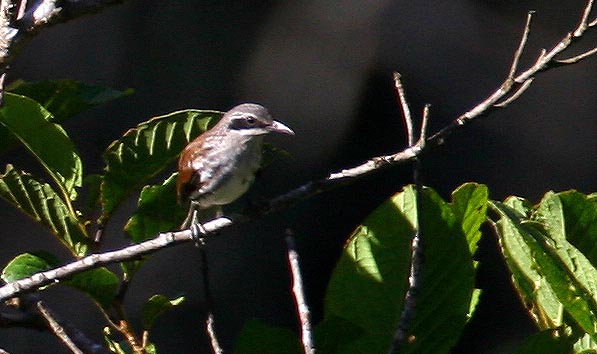Rhabdornises have traditionally been considered a separate family allied
to the Certhidae (northern creepers), and were once called "Philippine
creepers." Traditional paintings of Rhabdornises (e.g., Austin &
Singer 1961 or du Pont 1971) show them clinging to tree trunks like traditional
creepers. While they will sometimes forage along a limb, checking crevices,
they mostly do so by hopping, and the rest of their behavior is not particularly
creeper-like. They often forage in mixed species flocks (like tits or small
babblers) and they sit up on bare trees like starlings (left). They also
have brush-tipped tongues for flower feeding. Sibley (1996) thought it
might be a babbler. Recent DNA sequencing shows them to be most closely
related to starlings (Cibois & Cracraft 2004). Indeed, following the
approach of Sibley & Ahlquist (1990), that new research treats them
simply as a tribe among the starling subfamily in a huge Muscicapid assemblage.
However, their relative position within the group is not well-supported.
It is interesting to discover, however, that it appears that Rhabdornis
is more closely related to starlings than are the oxpeckers (Buphagus)
that have long been considered to be starlings (Cibois & Cracraft 2004).
For the moment I leave them as a traditional family, until further evidence
sorts it all out.
|
 All
of the Rhabdornis have a black mask, gray crown, and streaking to the sides
but they differ in facial and crown details, breast pattern, and the crispness
of the side streaking. The largest, most impressive, and rarest species
in the family is Grand Rhabdornis (right in a fine shot © Blake
Matheson). I have my own shot of this individual but Blake's photo
is much better. Grand Rhabdornis is restricted to montane forests in northern
Luzon where it usually occurs singly. We first picked this bird up in an
undulating flight, and tentatively called it a "Mountain Shrike!" It is
about that size and has a heavy, long bill for this genus. Although mostly
thought of as a high elevation species, we recorded it in mixed species
flocks down to 1000m elevation in the Sierra Madre on northern Luzon. Sometimes
those flocks also contained one or more Stripe-headed Rhabdornis. All
of the Rhabdornis have a black mask, gray crown, and streaking to the sides
but they differ in facial and crown details, breast pattern, and the crispness
of the side streaking. The largest, most impressive, and rarest species
in the family is Grand Rhabdornis (right in a fine shot © Blake
Matheson). I have my own shot of this individual but Blake's photo
is much better. Grand Rhabdornis is restricted to montane forests in northern
Luzon where it usually occurs singly. We first picked this bird up in an
undulating flight, and tentatively called it a "Mountain Shrike!" It is
about that size and has a heavy, long bill for this genus. Although mostly
thought of as a high elevation species, we recorded it in mixed species
flocks down to 1000m elevation in the Sierra Madre on northern Luzon. Sometimes
those flocks also contained one or more Stripe-headed Rhabdornis. |
Rather little is known about the breeding biology of Rhabdornis. Stripe-breasted has nested in cavities (Kennedy et al. 2000), and it is presumed that the other species do as well. They eat a variety of things: seeds, fruti, insects (sometimes flycatching for insects), and an ocassional tree frog (Kennedy et al. 2000). |
| Photos: The Stripe-headed Rhabdornis Rhabdornis
mysticalis (top, sometimes called "Stripe-sided Rhabdornis") was photographed
in the PICOP forest lands, south of Bislig, Mindanao, Philippines, on 26
Dec 2005. Blake Matheson photographed the Grand Rhabdornis
Rhabdornis
grandis (sometimes called "Long-billed Rhabdornis") on Mt. Polis, Luzon,
Philippines, on 1 Jan 2006 . The Stripe-breasted
Rhabdornis Rhabdornis inornatus was on Mt. Kitinglad, Mindanao,
Philippines, on 23 Dec 2005. Photos © 2006 D. Roberson,
except the Grand Rhabdornis attributed to © Blake Matheson, used with
permission; all rights reserved.
Bibliographic note There is no family book as yet, nor much written about this group at all. I look forward to the Handbook of the Birds of the World project reaching this group. Other literature cited: Austin, O.L., and A. Singer. 1961. Birds of the World. Edited by H. S. Zim. Golden Press, New York.TOP |